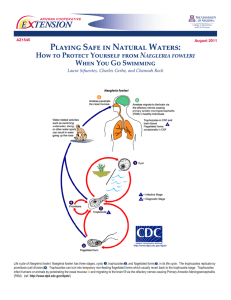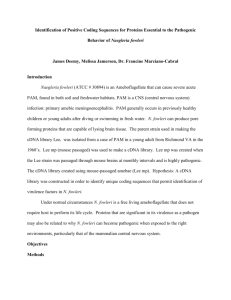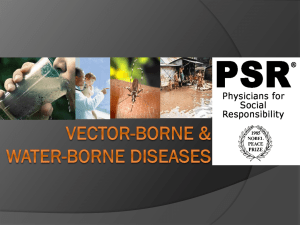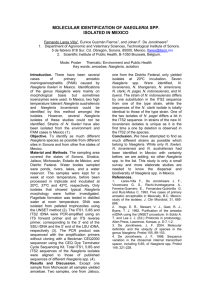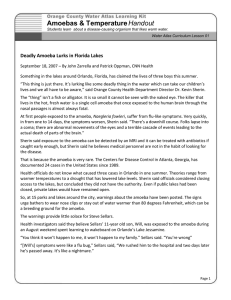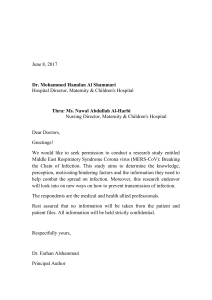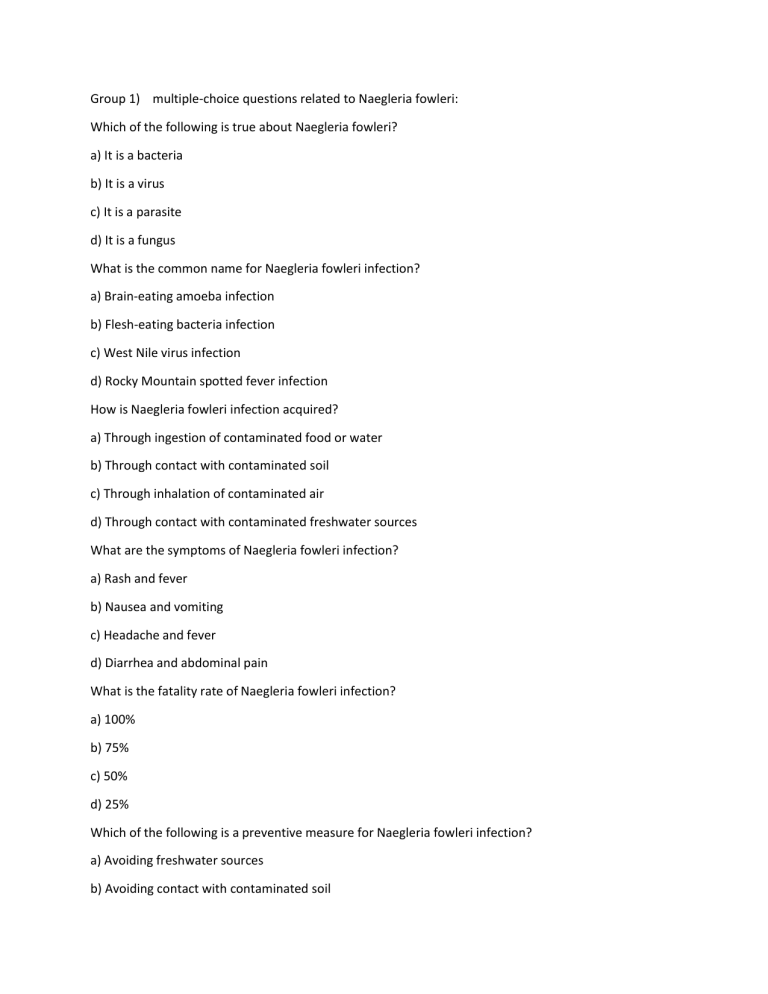
Group 1) multiple-choice questions related to Naegleria fowleri: Which of the following is true about Naegleria fowleri? a) It is a bacteria b) It is a virus c) It is a parasite d) It is a fungus What is the common name for Naegleria fowleri infection? a) Brain-eating amoeba infection b) Flesh-eating bacteria infection c) West Nile virus infection d) Rocky Mountain spotted fever infection How is Naegleria fowleri infection acquired? a) Through ingestion of contaminated food or water b) Through contact with contaminated soil c) Through inhalation of contaminated air d) Through contact with contaminated freshwater sources What are the symptoms of Naegleria fowleri infection? a) Rash and fever b) Nausea and vomiting c) Headache and fever d) Diarrhea and abdominal pain What is the fatality rate of Naegleria fowleri infection? a) 100% b) 75% c) 50% d) 25% Which of the following is a preventive measure for Naegleria fowleri infection? a) Avoiding freshwater sources b) Avoiding contact with contaminated soil c) Drinking boiled water d) All of the above What is the recommended treatment for Naegleria fowleri infection? a) Antibiotics b) Antifungal medications c) Antiparasitic medications d) None, as the infection is usually fatal Which of the following populations is most at risk for Naegleria fowleri infection? a) Children under 5 years old b) Adults over 65 years old c) Individuals with weakened immune systems d) All of the above group 2) some additional multiple choice questions about Naegleria fowleri: Which of the following is the primary way that Naegleria fowleri enters the human body? a) Ingestion of contaminated food or water b) Inhalation of contaminated air c) Direct contact with contaminated soil d) Through an open wound or through the nasal cavity What is the most common symptom of Naegleria fowleri infection? a) Fever b) Headache c) Nausea d) Stiff neck Where is Naegleria fowleri commonly found in the environment? a) Freshwater lakes and rivers b) Saltwater oceans and seas c) Forests and woodlands d) Deserts and arid regions Which of the following is the most effective way to prevent Naegleria fowleri infection? a) Drinking only bottled water b) Avoiding swimming in natural bodies of water c) Wearing nose plugs or clips when swimming or diving d) Regularly disinfecting and maintaining swimming pools and hot tubs What is the fatality rate of Naegleria fowleri infection? a) Less than 1% b) 5-10% c) 50-75% d) 90-95% group 3) more multiple-choice questions related to Naegleria fowleri: What is the most common route of infection for Naegleria fowleri? A) Ingestion of contaminated food or water B) Inhalation of contaminated aerosols C) Contact with contaminated soil or plants D) Entry through an open wound or mucous membrane What is the primary target organ of Naegleria fowleri? A) Brain B) Lungs C) Liver D) Kidneys Which of the following symptoms is NOT typically associated with Naegleria fowleri infection? A) Headache B) Stiff neck C) Fever D) Diarrhea How can Naegleria fowleri infection be prevented? A) Avoiding swimming in warm freshwater B) Boiling water before use C) Wearing nose clips during water activities D) All of the above Which of the following statements is TRUE about Naegleria fowleri? A) It is a bacteria B) It can be spread through person-to-person contact C) It is commonly found in tap water D) It causes a rare but often fatal brain infection called primary amebic meningoencephalitis. Answers to the first set of questions: 1. c) It is a parasite 2. a) Brain-eating amoeba infection 3. d) Through contact with contaminated freshwater sources 4. c) Headache and fever 5. a) 100% 6. d) All of the above 7. d) None, as the infection is usually fatal 8. c) Individuals with weakened immune systems Answers to the second set of questions: 1. d) Through an open wound or through the nasal cavity 2. b) Headache 3. a) Freshwater lakes and rivers 4. d) Regularly disinfecting and maintaining swimming pools and hot tubs 5. a) Less than 1% Answers to the third set of questions: 1. d) Entry through an open wound or mucous membrane 2. a) Brain 3. d) Diarrhea 4. d) All of the above 5. D) It causes a rare but often fatal brain infection called primary amebic meningoencephalitis.
